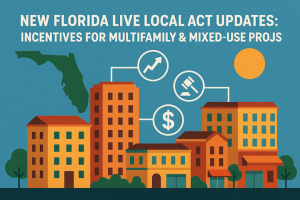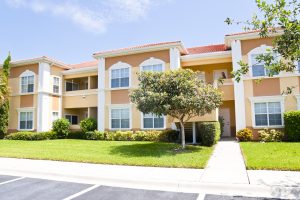The rules around the Florida Live Local Act just changed, and if you’re working on multifamily projects or mixed-use investments, this update affects your bottom line. Density bonuses, zoning overrides, and tax incentives are now clearer – and they open new doors for your next development. Keep reading to find out how these shifts can help you get more value from your properties. For a comprehensive overview of the changes, you can refer to the Florida Housing Coalition’s Live Local Act Overview.
Understanding the Florida Live Local Act

The Florida Live Local Act is reshaping the real estate landscape. Let’s break down what this means for you and your projects.
Key Incentives Overview
The Live Local Act packs a punch with three main incentives. First, density bonuses allow you to build more units on your land. Second, zoning overrides can fast-track your projects. Third, tax breaks boost your bottom line.These aren’t just small perks. They’re game-changers for your development plans. With these tools, you can create more housing and increase your profits at the same time. But here’s the catch: you need to know how to use them right. Many developers miss out because they don’t understand the fine print.
You’re in the driver’s seat if you’re a developer, investor, or planner. This act speaks directly to you. It’s not for homeowners or small-time landlords. It’s for the pros who shape Florida’s skylines.
Why does this matter? Because it gives you an edge. You can now build projects that were once off-limits. You can create affordable housing without sacrificing profits.
Think about it. When was the last time a law made your job easier and more profitable? That’s what the Live Local Act aims to do.
Importance for Multifamily Projects
Multifamily projects are the big winners here. The act lets you build more units per acre. That means more rent checks and better use of your land. But it’s not just about quantity. It’s about quality too. You can now mix market-rate and affordable units in ways that work for you and your tenants.
Here’s a real-world example: A 100-unit building could now become 150 units. That’s 50% more income potential from the same plot of land. And with the right mix, you’ll qualify for those juicy tax breaks too. Ready to supercharge your projects? Let’s dig into how density bonuses and zoning overrides can work for you.
Leveraging Density Bonuses
Density bonuses are your ticket to maximizing land use. They let you build more units than local zoning typically allows. But how do you cash in on this opportunity? First, know your numbers. The bonus depends on how many affordable units you include. For example, if 40% of your units are affordable, you might get a 100% density bonus. That’s double the units! But don’t just aim for the minimum. Smart developers are finding sweet spots where more affordable units actually lead to higher overall profits. It’s about balance and smart design. Remember, these bonuses aren’t automatic. You’ll need to apply and show how your project meets the criteria. But the payoff can be huge for those who do it right.
Exploring Zoning Overrides
Zoning overrides are your secret weapon against red tape. They can help you build in areas previously off-limits to multifamily or mixed-use projects. Here’s how it works: If your project includes affordable housing, you can override certain local zoning restrictions. This might mean building taller, denser, or in new areas altogether. But tread carefully. While the act gives you power, working with local communities is still crucial. The most successful developers use these overrides to create win-win situations for their projects and the neighborhood. Pro tip: Start conversations with local officials early. Show them how your project can help solve housing issues. This goodwill can smooth the path for your zoning requests.
Impact on Mixed-Use Investments
Mixed-use projects are getting a major boost from the Live Local Act. You can now combine residential, commercial, and even industrial spaces in new ways. Think beyond the typical apartment-over-retail model. The act allows for creative combinations that can revitalize entire neighborhoods. A project might include affordable housing, market-rate units, offices, and community spaces all in one. This flexibility is a goldmine for savvy investors. You’re not just building housing; you’re creating ecosystems where people live, work, and play. And that translates to higher property values and more stable long-term investments. But success here requires vision. The most profitable mixed-use projects under the new rules will be those that truly understand and serve their communities’ needs.
Tax Incentives for Developers
Let’s talk money. The tax incentives in the Live Local Act can seriously boost your project’s financial health. The tax benefits are where the rubber meets the road for many developers. These aren’t small credits – we’re talking about significant savings that can make or break a project’s viability. Here’s the headline: You can get property tax exemptions for the portion of your project dedicated to affordable housing. That means if 30% of your units are affordable, 30% of your property could be tax-exempt. But it gets better. These benefits can last for up to 75 years. That’s not just a short-term boost – it’s a long-term change to your financial calculations. There’s also a sales tax exemption on materials used for these affordable units. This can lead to huge savings during construction, improving your overall return on investment.
Strategies for Successful Application
Applying for these tax benefits isn’t a walk in the park, but the payoff is worth the effort. Here’s how to set yourself up for success: Start early. These applications take time and require detailed planning. Be meticulous with your numbers. Mistakes here can cost you big time. Work with experts. Tax laws are complex, and getting professional help can pay for itself many times over.
One key strategy: Design your project with these incentives in mind from the start. Don’t try to shoehorn them in later. The most successful applications come from projects that were built around these incentives from day one. Remember, these benefits are competitive. Not everyone who applies will get them. That’s why a strong, well-prepared application is crucial.

Real World Examples and Success Stories
Let’s look at some real wins. In Fort Pierce, a developer used the Live Local Act to green-light a project that had been stalled for years. By including affordable units, they got density bonuses that made the numbers work. You can read more about Fort Pierce’s implementation of the Live Local Act on the City of Fort Pierce website.
Another success story comes from Lee County. A mixed-use development there used zoning overrides to create a vibrant community hub. The project includes affordable housing, market-rate units, and commercial spaces. It’s now a model for future developments in the area. For more details on how Lee County is applying the Live Local Act, check out the Lee County Government website.
These aren’t isolated cases. Across Florida, developers are using the Live Local Act to unlock value in their properties. The key is understanding the act and applying it creatively to your specific situation.
By now, you should have a clear picture of how the Florida Live Local Act can benefit your projects. From density bonuses to tax incentives, the opportunities are significant. But remember, success requires careful planning and execution. Stay informed, work with experts, and be ready to innovate. Your next big development success could be just around the corner.
Ready to discuss your commercial real estate goals?
Nye Commercial Advisers provides investors and clients with a single-source solution for all their real estate needs — from brokerage and management to advisory services.
